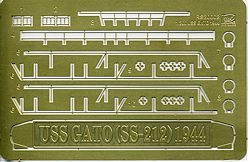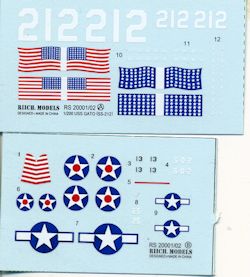
| KIT #: | RS20002 |
| PRICE: | $52.00 SRP |
| DECALS: | One option for the sub, two for the OS2U |
| REVIEWER: | Scott Van Aken |
| NOTES: | Includes OS2U |

| HISTORY |
USS Gato (SS-212) was the lead ship of her class of submarine in the United States Navy. She was the first Navy ship named for the gato, a species of small catshark found in waters along the west coast of Mexico.
Her keel was laid down 5 October 1940, by the Electric Boat Company of Groton, Connecticut. She was launched 21 August 1941 sponsored by Mrs. Royal E. Ingersoll, and commissioned 31 December 1941 with Lieutenant Commander William G. Myers in command.
After shakedown training at New London, Connecticut, Gato departed 16 February 1942, for Pearl Harbor via the Panama Canal and San Francisco. On her first war patrol from Pearl Harbor (20 April 10 June 1942), she unsuccessfully attacked a converted aircraft carrier 3 May before being driven away by the fierce depth charging of four destroyers off the Marshall Islands. On 24 May she was ordered to patrol the western approaches to Midway, taking station 280 miles westward during the Battle of Midway.
On her second war patrol (2 July 29 August 1942), she patrolled east of the Kurile Islands toward the Aleutian chain. She obtained four torpedo hits with unconfirmed damage to a ship 15 August 1942, and terminated her patrol at Dutch Harbor, Unalaska. Her third patrol (4 September 23 December 1942) included operations off Kiska; then she steamed via Midway and Pearl Harbor to Truk atoll, where her attack 6 December on a convoy was broken off by aerial bombs and a severe depth charge attack by three destroyers. This patrol terminated at Brisbane, Australia, 23 December 1942.
During her fourth war patrol (13 January 1943 26 February 1943), Gato torpedoed and sank transport Kenkon Maru 21 January; cargo ship Nichiun Maru on 29 January; and cargo ship Suruya Maru on 15 Februaryall off New Georgia, Solomon Islands. On her fifth war patrol (19 March 6 June 1943), she landed an Australian Intelligence party at Tope, Bougainville, 29 March 1943, and evacuated 27 children, nine mothers, and three nuns, transferring them 31 March to SC-531 off Ramos, Florida Island. During a submerged radar attack approach 4 April 1943, between Tanga and Lihir Islands, she was shaken so violently by three exploding depth charges that she returned to Brisbane for temporary repairs 11 April to 20 April. Gato landed more Australian commandos at Toep Harbor 29 May, transported more evacuees to Ramos Island, and then reconnoitered off Tarawa in the Gilbert Islands before putting in at Pearl Harbor 6 June 1943.
Gato was routed onward to the Mare Island Naval Shipyard for overhaul; returned to Pearl Harbor 22 August 1943; and conducted her sixth war patrol (6 September 28 October) via Truk and Bougainville in the Solomons to Brisbane. En route on 19 October she attacked a convoy, scoring hits for unknown damage to two large cargo ships. Her seventh war patrol (18 November 1943 10 January 1944) took her north of the Bismarck Archipelago. On 30 November she made a coordinated attack with Ray, sinking the cargo shipColumbia Maru. She rescued a Japanese soldier from a life-raft on 16 December; then attacked a convoy in the Saipan-Massau traffic lanes four days later to sink cargo ship Tsuneshima Maru and scored damaging hits on another freighter. After two hours of dodging depth charges, she finally evaded her attackers; surfaced and headed for Tingmon, the most likely course of the damaged cargo ship. Gato discovered a live depth charge on her deck at the same time that two enemy escorts headed in her direction were sighted. She outran them while disposing of the unexploded depth charge by setting it adrift, on a rubber raft. Although she did not overtake the cargo ship, she did sight a convoy. On 2 December her chase was foiled by a float plane finally driven off by her gunners. She concluded the patrol at Milne Bay, New Guinea, 10 January 1944.
Gato departed Milne Bay 2 February 1944, to conduct her eighth war patrol in the Bismarck-New Guinea-Truk area. She sank a trawler off Truk 15 February, transport Daigen Maru No.3 the 26th, and cargo ship Okinoyama Maru No.3 12 March. Two other trawlers were destroyed by her gunfire before she returned to Pear Harbor 1 April 1944.
On her ninth war patrol (30 May 1944 21 June 1944) Gato took Vice Admiral Charles A. Lockwood to Midway; completed photographic reconnaissance of Woleai Island, served on lifeguard station for air strikes on Truk 11 June to 18 June, and terminated her patrol at Majuro atoll. On 15 July 1944, she was underway on her 10th war patrol taking lifeguard station for the carrier-based air strike on Chichi Jima, during which she rescued two aviators. She returned to Pearl Harbor on 2 September 1944, proceeded to Mare Island for overhaul and then returned to Pearl Harbor.
On her 11th war patrol (28 January 13 March 1945,) Gato patrolled the Yellow Sea as a unit of a coordinated attack group which included Jallao (SS-368) and Sunfish (SS-281). She sank a coast defense ship on 14 February and cargo ship Tairiku Maru on 21 February, then returned to Guam. She departed on her 12th war patrol 12 April 1945, taking lifeguard station in support of the invasion of Okinawa. On the night of 22 April and 23 April she had a brief contest with two Japanese submarines and narrowly missed destruction as well-aimed torpedoes came close. Between 27 April and 30 April she rescued 10 Army aviators from shallow water near the beaches of Toi Misaki, Kyushu. She returned to Pearl Harbor 3 June 1945.
On her 13th war patrol Gato departed 8 July for lifeguard station for air strikes on Wake Island and then off the eastern coast of Honshu. She received word of "Cease Fire" 15 August while making an attack approach on a sea truck; steamed into Tokyo Bay the 31st; remained for the signing of surrender documents on board Missouri 2 September; and then departed the following day via Pearl Harbor and the Panama Canal to the New York Naval Shipyard, where she decommissioned 16 March 1946. She served for a number of years as a naval reserve training ship at New York and later at Baltimore, Maryland, until her name was struck from the Naval Vessel Register on 1 March 1960. She was sold for scrapping 25 July 1960, to the Northern Metals Company of Philadelphia, Pennsylvania.
Gato received the Presidential Unit Citation in recognition of daring exploits during war patrols four through eight and 13 battle stars for service in World War II.
Several Gato class submarines are still extant as museums and SSN-615 was named Gato when launched.
| THE KIT |
 It seems like the Gato is a popular subject as it has been kitted many times in all manner of scales. This one is in 1/200 and still makes for a very large boat with a hull length of over 18 inches. It also puts it in scale with several of the Nichimo submarine kits.
It seems like the Gato is a popular subject as it has been kitted many times in all manner of scales. This one is in 1/200 and still makes for a very large boat with a hull length of over 18 inches. It also puts it in scale with several of the Nichimo submarine kits.
The hull sections are nicely done and have reinforcement ribs molded in place to keep it properly stiff and provide support for the long upper deck piece. An interesting option not often seen on sub kits is that you can have the upper forward torpedo tubes loaded with supplied torpedoes and to have the doors open and ready for firing. Of course, you can leave this off and install the closed door sections. I would also imagine that if you left off the lower hull, you could model this as a waterline kit.
 Thanks to the largeish scale, the amount of detail and small parts is a lot higher than with smaller scale boats. This includes a full array of deck fittings and the rather complex looking propeller guards in the rear. Diving planes can be molded up or lower. The kit also comes with a properly detailed deck gun, and two anti-aircraft guns as well as an impressive conning tower assembly. A well done photo etch fret is
Thanks to the largeish scale, the amount of detail and small parts is a lot higher than with smaller scale boats. This includes a full array of deck fittings and the rather complex looking propeller guards in the rear. Diving planes can be molded up or lower. The kit also comes with a properly detailed deck gun, and two anti-aircraft guns as well as an impressive conning tower assembly. A well done photo etch fret is provided for railings, some deck fittings, a name tag and the torpedo tube doors.
provided for railings, some deck fittings, a name tag and the torpedo tube doors.
The option of either photo-etch or stretch your own rails around the guns and along the side of the conning tower are provided. If you wish to stretch your own sprue, the stanchions are provided for this purpose. A neat addition to this kit is an OS2U in clear plastic. This one comes complete with small bombs for under the wing. The decal sheet for this plane gives markings for either a very early war plane with the rudder stripes or a post September 1943 version.
Instructions are well drawn with all options clearly marked. There is a large full size painting sheet included to assist with colors and markings placements. The two small decal sheets are nicely printed. For those wondering how to pose the flags, often applying them to aluminum foil or very thin lead sheet works well.
| CONCLUSIONS |
So here we have another very nicely done submarine kit for those who do not have room for the larger 1/72 and 1/144 scale boats, but want something larger than 1/350, this is a good option.
| REFERENCES |
http://en.wikipedia.org February 2013
Thanks to www.dragonmodelsusa.com for the review kit. You can find this kit at your favorite hobby shop or on-line retailer.
If you would like your product reviewed fairly and fairly quickly, please contactthe editor or see other details in the